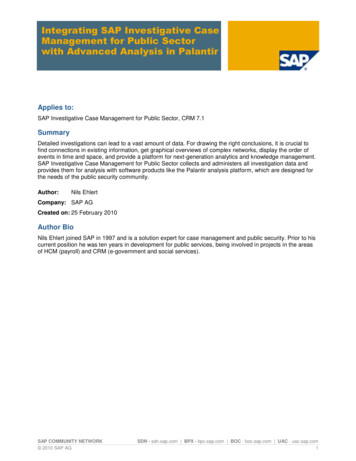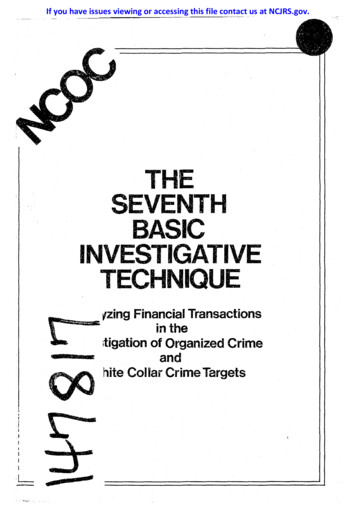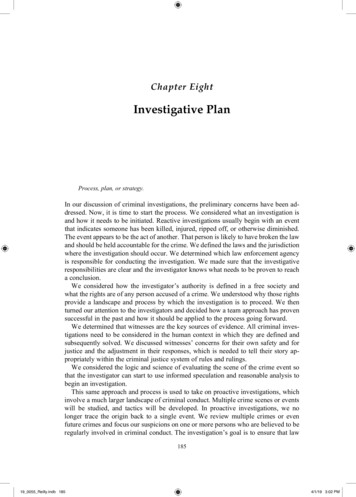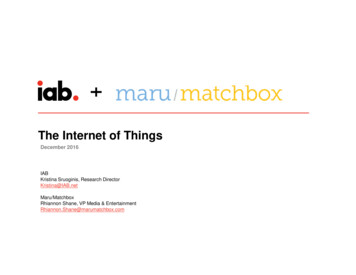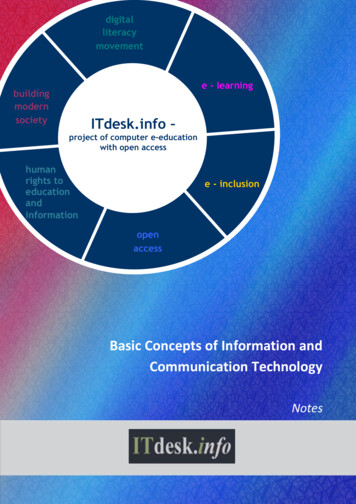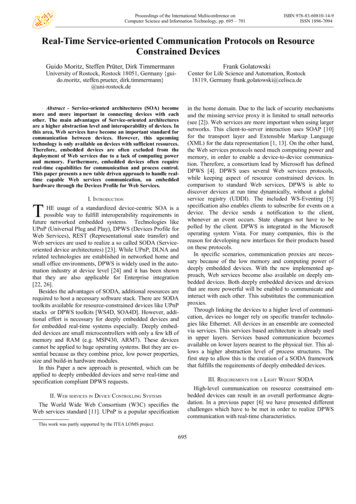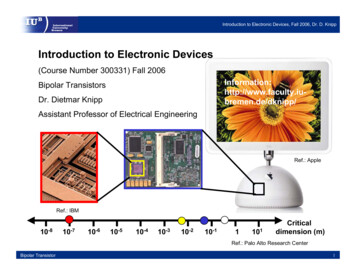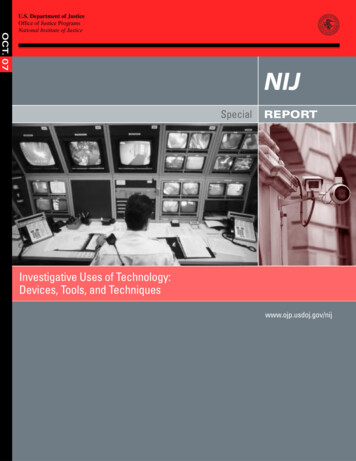
Transcription
OCT. 07U.S. Department of JusticeOffice of Justice ProgramsNational Institute of JusticeSpecialREPORTInvestigative Uses of Technology:Devices, Tools, and Techniqueswww.ojp.usdoj.gov/nij
U.S. Department of JusticeOffice of Justice Programs810 Seventh Street N.W.Washington, DC 20531Peter D. KeislerActing Attorney GeneralCybele K. DaleyActing Assistant Attorney GeneralDavid W. HagyActing Principal Deputy Director, National Institute of JusticeThis and other publications and products of the National Instituteof Justice can be found at:National Institute of Justicewww.ojp.usdoj.gov/nijOffice of Justice ProgramsInnovation Partnerships Safer Neighborhoodswww.ojp.usdoj.gov
01-Chap 1 InvestigTech10/10/0712:41 PMPage iOCT. 07Investigative Uses of Technology:Devices,Tools, and TechniquesNCJ 213030
01-Chap 1 InvestigTech10/10/0712:41 PMPage iiDavid W. HagyActing Principal Deputy Director, National Institute of JusticeThis document is not intended to create, does not create, and may not be relied upon to createany rights, substantive or procedural, enforceable by law by any party in any matter civil or criminal.Photos used in this document are taken from public Web sites; they are in no way an endorse ment of the product illustrated.Opinions or points of view expressed in this document represent a consensus of the authorsand do not necessarily reflect the official position or policies of the U.S. Department of Justice.The products, manufacturers, and organizations discussed in this document are presented forinformational purposes only and do not constitute product approval or endorsements by the U.S.Department of Justice.This material should not be relied upon as legal advice. Those considering legal issues related tothe use of high-tech materials should consult with their legal counsel.This document was prepared under Interagency Agreement #2003–IJ–R–029 between theNational Institute of Justice and the National Institute of Standards and Technology, Office ofLaw Enforcement Standards.The National Institute of Justice is a component of the Office of Justice Programs, which alsoincludes the Bureau of Justice Assistance; the Bureau of Justice Statistics; the CommunityCapacity Development Office; the Office for Victims of Crime; the Office of Juvenile Justiceand Delinquency Prevention; and the Office of Sex Offender Sentencing, Monitoring,Apprehending, Registering, and Tracking (SMART).
01-Chap 1 InvestigTech10/10/0712:41 PMPage iiiTechnology Working Group forInvestigative Uses of High Technology*Planning panelJames R. DoyleFirst Group AssociatesNew York, New YorkJoseph DukeDrive-Spies, LLCClarkston, MichiganBarry GrundyComputer Crime Investigator/Special AgentNASA Office of the Inspector GeneralOffice of InvestigationsComputer Crimes DivisionGoddard Space Flight CenterGreenbelt, MarylandKeith HodgesSenior Instructor, Legal DivisionFederal Law Enforcement Training CenterGlynco, GeorgiaDan MaresPresidentMares and CompanyLawrenceville, GeorgiaMark J. MenzM. J. Menz and AssociatesFolsom, CaliforniaRobert MorgesterDeputy Attorney GeneralState of California Department of JusticeOffice of the Attorney GeneralCriminal Law DivisionSacramento, CaliforniaPhillip OsbornSenior Special AgentNational Program ManagerCyber Crimes Center (C3)Bureau of Immigration and CustomsEnforcement (ICE)U.S. Department of Homeland SecurityFairfax, VirginiaJohn OteroLieutenantComputer Crimes SquadNew York Police DepartmentNew York, New YorkDavid PooleChiefInformation Operations and InvestigationsAir Force Office of Special InvestigationsAndrews Air Force Base, MarylandMichael WeilHuron Consulting GroupChicago, IllinoisTechnology working groupmembersTodd AbbottVice PresidentCorporate Information SecurityBank of AmericaCharlotte, North CarolinaAbigail AbrahamAssistant Attorney GeneralIllinois Attorney General’s OfficeChicago, IllinoisDavid ArnettDetectiveArizona Department of Public SafetyPhoenix, Arizonaiii
01-Chap 1 InvestigTech10/10/0712:41 PMPage ivDave AusdenmooreDetectiveRegional Electronics and ComputerInvestigation SectionHamilton County Sheriff’s Office/Cincinnati Police DepartmentCincinnati, OhioRick AyersNational Institute of Standards andTechnologyGaithersburg, MarylandKen BasoreDirector of Professional ServicesGuidance Software (EnCase)Reston, VirginiaDavid BentonChief Systems EngineerHome DepotAtlanta, GeorgiaWalter E. BruehsForensics ExaminerForensic Audio, Video and ImagingAnalysis UnitFederal Bureau of InvestigationQuantico, VirginiaCarleton BryantStaff AttorneyKnox County Sheriff’s OfficeKnoxville, TennesseeScott ChristensenSergeantComputer Crimes/ICDC UnitNebraska State PatrolOmaha, NebraskaBill CraneAssistant DirectorNational White Collar Crime CenterFairmont, West VirginiaivDon FlynnAttorney AdvisorDepartment of DefenseCyber Crime CenterLinthicum, MarylandG.D. GriffinAssistant Inspector in ChargeDigital Evidence UnitU.S. Postal Inspection ServiceDulles, VirginiaAmber HaqqaniDirector, Digital EvidenceAmerican Academy of Applied ForensicsCentral Piedmont Community CollegeCharlotte, North CarolinaDave HeslepSergeantTechnical Assistance Section SupervisorMaryland State PoliceTechnical Investigation DivisionColumbia, MarylandChip JohnsonLieutenantSouth Carolina Computer Crime CenterColumbia, South CarolinaNigel JonesNSLEC Centre for National High TechCrime TrainingWyboston Lakes Business andLeisure CentreBedfordshire, EnglandKeith KellyTelecommunication SpecialistWashington, D.C.Tom KolpackiDetectiveAnn Arbor PoliceLivonia, Michigan
01-Chap 1 InvestigTech10/10/0712:41 PMPage vAl LewisSpecial AgentInvestigator/DE ExaminerUSSS Electronic Crimes Task ForceChicago, IllinoisHenry (Dick) ReeveGeneral CounselDeputy District AttorneyDenver District Attorney’s OfficeDenver, ColoradoGlenn LewisComputer Training SpecialistTraining ServicesSEARCH Group, IncSacramento CaliforniaJim Riccardi, Jr.Electronic Crime SpecialistCyberScience LabNational Law Enforcement andCorrections Technology Center–NortheastRome, New YorkThomas MushenoForensic ExaminerForensic Audio, Video and Image AnalysisFederal Bureau of InvestigationEngineering Research FacilityQuantico, VirginiaLarissa O’BrienChief, Research and DevelopmentInformation Operations and InvestigationsAir Force Office of Special InvestigationsAndrews Air Force Base, MarylandTimothy O’SheaAssistant U.S. AttorneyWestern District of WisconsinSenior Litigation CounselComputer Crime andTelecommunications CoordinatorMadison, WisconsinThom QuinnProgram ManagerCalifornia Department of JusticeAdvanced Training CenterRancho Cordova, CaliforniaRichard SalgadoSenior CounselComputer Crime and IntellectualProperty SectionU.S. Department of JusticeWashington, D.C.Chris StippichPresidentDigital Intelligence, Inc.Waukesha, WisconsinFacilitatorsSusan BallouProgram Manager for Forensic SciencesOffice of Law Enforcement StandardsNational Institute of Standards andTechnologyGaithersburg, MarylandAnjali R. SwientonPresident & CEOSciLawForensics, Ltd.Germantown, Maryland*This information reflects each panel member’s professional affiliation during the time that the majority of the technology workinggroup’s work was performed.v
01-Chap 1 InvestigTech10/10/0712:41 PMPage viiContentsTechnology Working Group for Investigative Uses of High Technology. . . . . . . . iiiIntroduction . . . . . . . . . . . . . . . . . . . . . . . . . . . . . . . . . . . . . . . . . . . . . . . . . . . . . 1Chapter 1. Techniques . . . . . . . . . . . . . . . . . . . . . . . . . . . . . . . . . . . . . . . . . . . . . 3Introduction . . . . . . . . . . . . . . . . . . . . . . . . . . . . . . . . . . . . . . . . . . . . . . . . . . 3Investigative assistance . . . . . . . . . . . . . . . . . . . . . . . . . . . . . . . . . . . . . . . . 3Information gathering . . . . . . . . . . . . . . . . . . . . . . . . . . . . . . . . . . . . . . . . . . 3Digital evidence. . . . . . . . . . . . . . . . . . . . . . . . . . . . . . . . . . . . . . . . . . . . . . . 6Electronic communications . . . . . . . . . . . . . . . . . . . . . . . . . . . . . . . . . . . . . . 8Telecommunications . . . . . . . . . . . . . . . . . . . . . . . . . . . . . . . . . . . . . . . . . . 11Video surveillance . . . . . . . . . . . . . . . . . . . . . . . . . . . . . . . . . . . . . . . . . . . . 12Consensual monitoring . . . . . . . . . . . . . . . . . . . . . . . . . . . . . . . . . . . . . . . . 13Tracking . . . . . . . . . . . . . . . . . . . . . . . . . . . . . . . . . . . . . . . . . . . . . . . . . . . . 13Practical example. . . . . . . . . . . . . . . . . . . . . . . . . . . . . . . . . . . . . . . . . . . . . 14Chapter 2. Tools and Devices . . . . . . . . . . . . . . . . . . . . . . . . . . . . . . . . . . . . . . 21Introduction . . . . . . . . . . . . . . . . . . . . . . . . . . . . . . . . . . . . . . . . . . . . . . . . . 21Power concerns with battery-operated devices . . . . . . . . . . . . . . . . . . . . . 21Access-control devices . . . . . . . . . . . . . . . . . . . . . . . . . . . . . . . . . . . . . . . . 22Answering machines and voice mail systems (digital and analog) . . . . . . . 24Audio: Digital tools used to conduct examinations of audio formats . . . . . 26Caller ID devices . . . . . . . . . . . . . . . . . . . . . . . . . . . . . . . . . . . . . . . . . . . . . 28Cell phones . . . . . . . . . . . . . . . . . . . . . . . . . . . . . . . . . . . . . . . . . . . . . . . . . 30Computers (desktops and laptops) . . . . . . . . . . . . . . . . . . . . . . . . . . . . . . . 34Credit card fraud devices . . . . . . . . . . . . . . . . . . . . . . . . . . . . . . . . . . . . . . 36vii
01-Chap 1 InvestigTech10/10/0712:41 PMPage viiiSPECIAL REPORT / OCT. 07Customer or user cards and devices. . . . . . . . . . . . . . . . . . . . . . . . . . . . . . 38Data preservation (duplicating, imaging, copying). . . . . . . . . . . . . . . . . . . . 40Detection and interception (wireless) . . . . . . . . . . . . . . . . . . . . . . . . . . . . . 44Digital cameras and Web cameras . . . . . . . . . . . . . . . . . . . . . . . . . . . . . . . 46Digital security cameras . . . . . . . . . . . . . . . . . . . . . . . . . . . . . . . . . . . . . . . 48Encryption tools and passphrase protection . . . . . . . . . . . . . . . . . . . . . . . . 50Facsimile (fax) . . . . . . . . . . . . . . . . . . . . . . . . . . . . . . . . . . . . . . . . . . . . . . . 53Global positioning system devices . . . . . . . . . . . . . . . . . . . . . . . . . . . . . . . 55Home entertainment. . . . . . . . . . . . . . . . . . . . . . . . . . . . . . . . . . . . . . . . . . 57Internet tools. . . . . . . . . . . . . . . . . . . . . . . . . . . . . . . . . . . . . . . . . . . . . . . . 59Internet tools to identify users and Internet connections (investigative) . . 61Keystroke monitoring . . . . . . . . . . . . . . . . . . . . . . . . . . . . . . . . . . . . . . . . . 68Mass media copiers and duplicators. . . . . . . . . . . . . . . . . . . . . . . . . . . . . . 73Pagers . . . . . . . . . . . . . . . . . . . . . . . . . . . . . . . . . . . . . . . . . . . . . . . . . . . . . 74Pens and traps . . . . . . . . . . . . . . . . . . . . . . . . . . . . . . . . . . . . . . . . . . . . . . . 76Personal digital assistants . . . . . . . . . . . . . . . . . . . . . . . . . . . . . . . . . . . . . . 77Removable storage media and players . . . . . . . . . . . . . . . . . . . . . . . . . . . . 80Sniffers . . . . . . . . . . . . . . . . . . . . . . . . . . . . . . . . . . . . . . . . . . . . . . . . . . . . 84Steganography . . . . . . . . . . . . . . . . . . . . . . . . . . . . . . . . . . . . . . . . . . . . . . 86Vehicle black boxes and navigation systems . . . . . . . . . . . . . . . . . . . . . . . . 87Video and digital image analysis tools . . . . . . . . . . . . . . . . . . . . . . . . . . . . . 89Voice recorder (digital). . . . . . . . . . . . . . . . . . . . . . . . . . . . . . . . . . . . . . . . . 91viii
01-Chap 1 InvestigTech10/10/0712:41 PMPage ixINVESTIGATIVE USES OF TECHNOLOGY: DEVICES, TOOLS, AND TECHNIQUESChapter 3. Legal Issues for the Use of High Technology. . . . . . . . . . . . . . . . . . 93Introduction . . . . . . . . . . . . . . . . . . . . . . . . . . . . . . . . . . . . . . . . . . . . . . . . . 93Constitutional issues . . . . . . . . . . . . . . . . . . . . . . . . . . . . . . . . . . . . . . . . . . 93Searches and seizures pursuant to warrants. . . . . . . . . . . . . . . . . . . . . . . . 94Warrantless searches . . . . . . . . . . . . . . . . . . . . . . . . . . . . . . . . . . . . . . . . . 96Statutes that affect the seizure and search of electronic evidence. . . . . . . 98Appendix A. Glossary . . . . . . . . . . . . . . . . . . . . . . . . . . . . . . . . . . . . . . . . . . . 107Appendix B. Technical Resources List . . . . . . . . . . . . . . . . . . . . . . . . . . . . . . . 117Appendix C. Hacked Devices . . . . . . . . . . . . . . . . . . . . . . . . . . . . . . . . . . . . . 131Appendix D. Disclosure Rules of ECPA . . . . . . . . . . . . . . . . . . . . . . . . . . . . . . 135Appendix E. Sample Forms . . . . . . . . . . . . . . . . . . . . . . . . . . . . . . . . . . . . . . . 137Appendix F. References . . . . . . . . . . . . . . . . . . . . . . . . . . . . . . . . . . . . . . . . . . 151Appendix G. List of Reviewing Organizations . . . . . . . . . . . . . . . . . . . . . . . . . 153Index . . . . . . . . . . . . . . . . . . . . . . . . . . . . . . . . . . . . . . . . . . . . . . . . . . . . . . . . 155ix
01-Chap 1 InvestigTech10/10/0712:41 PMPage 1IntroductionThis special report is intended to be a resource to any law enforcement personnel (inves tigators, first responders, detectives, prosecutors, etc.) who may have limited or noexperience with technology-related crimes or with the tools and techniques available toinvestigate those crimes. It is not all inclusive. Rather, it deals with the most commontechniques, devices, and tools encountered.Technology is advancing at such a rapid rate that the information in this special reportmust be examined in the context of current technology and practices adjusted as appro priate. It is recognized that all investigations are unique and the judgment of investigatorsshould be given deference in the implementation of this special report. Circumstances ofindividual cases and Federal, State, and local laws/rules may require actions other thanthose described in this special report.When dealing with technology, these general forensic and procedural principles shouldbe applied: Actions taken to secure and collect evidence should not change that evidence. Activity relating to the seizure, examination, storage, or transfer of electronic evidenceshould be fully documented, preserved, and available for review. Specialized training may be required for the examination of many of the devicesdescribed in this special report. Appropriate personnel should be consulted prior toconducting any examination. For more information on the seizure or examination ofelectronic evidence, see the other special reports in this series: Electronic CrimeScene Investigation: A Guide for First Responders (www.ojp.usdoj.gov/nij/pubs-sum/187736.htm); Forensic Examination of Digital Evidence: A Guide for Law htm); Digital Evidence in the Courtroom: AGuide for Law Enforcement and Prosecutors (www.ojp.usdoj.gov/nij/pubs-sum/211314.htm); and Investigations Involving the Internet and Computer ).Note: All Web links mentioned in this document were active as of the date ofpublication.1
01-Chap 1 InvestigTech10/10/0712:41 PMPage 3Chapter 1. TechniquesNote:Terms that are defined in the glossary (Appendix A) appear in bold italics ontheir first appearance in the body of the report.IntroductionThis chapter describes a variety of techniques and resources that may help in investiga tions. The first few pages discuss traditional investigative techniques as they relate toadvanced technology, and the following sections provide an awareness of technologiesthat may affect the investigation.Law enforcement officers should not be overwhelmed by technology. The presence oravailability of technology may enhance the investigation or provide information that maynot otherwise be available to the investigator. Although technology can provide signifi cant information, investigators should remember that technology does not replace tradi tional investigative techniques.Investigative assistanceDue to the nature of technology, particularly in crimes committed on the Internet, criminalbehavior often occurs across jurisdictional boundaries. It is important, therefore, for lawenforcement officers to collaborate with other agencies at the Federal, State, and locallevels to successfully investigate these types of crimes and apprehend the offenders.Officers using technology in investigations should also be aware that Federal, State, andlocal agencies and professional organizations can provide training and technical andinvestigative assistance. See Appendix B, Technical Resources List, for more information.Information gatheringInformation of investigative value can be collected from a variety of sources includingpeople, places, and things (see chapter 2). The information can be collected throughinterviews, crime scene and location searches, publicly available information, lawenforcement databases, and legal process.3
01-Chap 1 InvestigTech10/10/0712:41 PMPage 4SPECIAL REPORT / OCT. 07InterviewsWhile conducting interviews, it is important to determine the victim’s, suspect’s, orwitness’s skill level as it relates to technology. The answers to the following questionscan affect the investigative plan: What technology (e.g., digital camera, pager, cell phone, computer, personal digitalassistant (PDA)) did the parties involved have knowledge of, use of, or access to, andat what locations? What is the skill level of the user? What is the security of the device?— Physical security (e.g., located in a locked facility).— Data security (e.g., passphrase protection, firewall). Who is the owner of the equipment? What accounts, logins, and passwords are on the device or system? What logs are available (e.g., physical or electronic)? What is the frequency of use (e.g., hardware, software, device, Internet)? How was the device used (e.g., communication device, data storage device)? Is there offsite storage? If so, where (physical storage, e.g., backup tapes or disksand/or Internet or remote data storage)? Was information transmitted to or shared with other recipients? If so, how (e.g., online,telephone, personal) and to whom? What services or service providers are used? Who is the system administrator? Who else may have administrative privileges? Is there remote access to the devices or computer systems? Is the system patched and up to date?For additional computer- or Internet-related interview questions, consult a technicalexpert.Crime scene and location searchesWhether responding to a crime scene or preparing to execute a search warrant, a consid eration in the search process is identifying the possible location(s) of information withinvestigative value. The physical location of the devices or subjects may not necessarilycorrespond to the location of the data. Information may be found in various locations ormay be associated with various devices. In conducting the search, the investigator maywant to consider the following:4
01-Chap 1 InvestigTech10/10/0712:41 PMPage 5INVESTIGATIVE USES OF TECHNOLOGY: DEVICES, TOOLS, AND TECHNIQUES Work, personal, or public access devices or systems involved (e.g., work computer,Internet café, library). Computer equipment (e.g., computer, PDA, printer, media, webcam). Computer accessories such as cradles, charging devices, batteries, or a notebookcomputer bag with no computer may indicate the existence of the corresponding sup ported device. Storage media (e.g., memory cards, ThumbDrives ). Consumer electronics and accessories (e.g., answering machines, cell phones, pagers,fax/scanner/copier machines, digital cameras, caller ID boxes). The presence of Internet or network connectivity (e.g., phone, digital subscriber line(DSL), and cable modems; hubs, routers, and wireless devices). Documents or notes containing access information (e.g., user names, passwords) orother evidence. Books, manuals, warranty info, and software boxes (indicating potential presence ofcorresponding devices or software). Dumpster diving, trash runs, or recovering abandoned property. Bills related to the purchase of products or services. Presence of commercial video equipment (e.g., automated teller machines (ATMs)) ator adjacent to the crime scene. Alarm or access-control systems. Vehicles—presence of OnStar , black box, global positioning system(GPS),LoJack , EZPassSM, or related items.Note: For information on preservation, collection, and transport of digital evidence,see the digital evidence section in this chapter.Publicly available informationInformation may be obtained from the following sources: Publicly available government records. Internet searches (e.g., search engines, Web sites, newsgroups, discussion groups,chat rooms).5
01-Chap 1 InvestigTech10/10/0712:41 PMPage 6SPECIAL REPORT / OCT. 07 Internet registries (see chapter 2, section on Internet tools to identify users andInternet connections (investigative), overview). Commercially available databases of personal and corporate records (e.g., AutoTrak,LexisNexis , ChoicePoint , credit bureaus).Law enforcement databasesIn addition to traditional law enforcement resources, several Government-funded databas es are available, such as the following: Consumer Sentinel (www.FTC.gov). Internet Crime Complaint Center (www.IC3.gov). Financial Crimes Enforcement Network (http://FINCEN.gov). National Center for Missing & Exploited Children (www.NCMEC.org).Legal processLegal process may be required to compel the production of certain types of records.State law may impose additional statutory requirements in various forms of compulsorylegal process. Types of process are discussed in more detail in Chapter 3, Legal Issues.EncryptionEncryption may be used to protect or hide important or incriminating data or communi cations. (See chapter 2, section on encryption tools and passphrase protection.) The bestmethods for obtaining passwords to decrypt this data are interviews and crime scenesearches. With the number of passwords that users are required to remember, a possibilityexists that passwords may be stored on paper or other electronic devices.Digital evidenceVolatility of digital evidenceDigital data are stored in various forms (e.g., random access memory (RAM), read onlymemory (ROM), hard drives, and other magnetic or optical media) and are subject toinadvertent alteration, degradation, or loss. Almost any activity performed on a device,whether inadvertent or intentional (e.g., powering up or shutting down), can alter ordestroy potential evidence. In addition, loss of battery power in portable devices,changes in magnetic fields, exposure to light, extremes in temperature, and even roughhandling can cause loss of data. Due to these factors, steps should be taken in a timelymanner to preserve data.Special precautions should be taken when documenting, collecting, preserving, andexamining digital evidence. Failure to do so may render it unusable, result in an inaccu rate conclusion, or affect its admissibility or persuasiveness. Consult a trained professional6
01-Chap 1 InvestigTech10/10/0712:41 PMPage 7INVESTIGATIVE USES OF TECHNOLOGY: DEVICES, TOOLS, AND TECHNIQUESif any questions arise about handling specific digital devices or media. Activities thatshould be avoided include the following: Putting a Post-it note (adhesive material) on the surface of a CD or floppy disk. Using permanent markers to label CDs. Placing magnetic media close to strong magnetic fields (e.g., radio equipment in cartrunks, electric motors, computer monitors). Placing magnetic media in high-temperature environments. Exposing optical media (e.g., CD-ROMs) to light or high-temperature environments. Exposing media to static electricity (e.g., transporting or storing media in plastic bags,photocopying). Rough handling of a seemingly sturdy container (e.g., hard drives, laptop computers).Wireless devices in use by law enforcement should be disabled prior to enteringa search site to avoid communicating (pairing) with subject devices.Subjects may boobytrap electronic devices to cause data loss or personal injury.Explosive devices have been placed inside computer cases and set to detonate when theon/off switch is pressed.Many electronic devices contain memory that requires continuous power (such asa battery or AC power) to maintain information. Data can be easily lost by unplugging thepower source or allowing the battery to discharge. To avoid this, place the device in itscharger or immediately replace the batteries. If custody of the device is transferred,receiving personnel must be alerted to the power requirements of the device.Importance of digital evidenceData and records obtained from digital media and Internet usage can yield significantinvestigative leads. Digital information should be handled in a manner that includes a fullydocumented chain of custody initiated at the point of seizure. Analysis of digital evidenceshould be performed on a forensic duplicate by trained personnel while maintaining theintegrity of the original evidence. Federal, State, and local agencies; governmentresources; private entities; or academic institutions may have capabilities that can assistwith the analysis of the following: Computer forensic examinations. A discussion of computer forensic capabilities can befound in Forensic Examination of Digital Evidence: A Guide for Law htm). An examination of electronic mediacan reveal the following:7
01-Chap 1 InvestigTech10/10/0712:41 PMPage 8SPECIAL REPORT / OCT. 07— Registered ownership and software registration information.— Journals, diaries, and logs.— Databases, spreadsheets, pictures, and documents.— Deleted and hidden files.— Internet activity.— Communications-user input (e.g., e-mail, chat logs).— Communications-data transfers (e.g., peer to peer (P2P), newsgroups)— Financial records.— Data to be used in a timeline analysis.— Contraband. Audio analysis. Audio recordings obtained by law enforcement may contain ambientnoise that interferes with interpretation. Technology exists to analyze and improve thequality of the recordings. Video analysis. Video recordings obtained by law enforcement are often surveillancetapes, which are multiplexed (multiple or split-screen views), proprietary in format, willneed to be viewed on a specific platform, or are of poor quality. Technology exists toanalyze and improve the quality of the recorded images. The technology may be avail able from the manufacturer or end user of the video equipment. Picture analysis. Technology exists to analyze and improve the quality of still images.The technology may be available from the manufacturer or end user of the equipment.Electronic communicationsElectronic communications (e.g., e-mail, text messaging, picture messaging) may beavailable from Internet service providers (ISPs), pager companies, cellular or wirelessphone service providers, public access (e.g., wireless hotspots, Internet cafes, publiclibraries, academic institutions), and suspect or victim computers.E-mailE-mail can be the starting point or a key element in many investigations. It is the elec tronic equivalent of a letter or a memo and may include attachments or enclosures.E-mail can provide many investigative leads, including the following:8 Possible point of origin, which can lead to the suspect’s location. Identification of the account, which can lead to the suspect.
01-Chap 1 InvestigTech10/10/0712:41 PMPage 9INVESTIGATIVE USES OF TECHNOLOGY: DEVICES, TOOLS, AND TECHNIQUES— Investigators can proactively communicate with a suspect to gather identifying infor mation (e.g., an e-mail can be sent to communicate with a suspect and ultimately toestablish identity). Transactional information related to the Internet connection. Direct evidence of the crime (e.g., the content of communications between suspectand victim may be contained in an e-mail).For investigative purposes, the complete e-mail header information may be needed foroptimum results. For additional information see Investigations Involving the Internet andComputer Networks (www.ojp.usdoj.gov/nij/pubs-sum/210798.htm).Refer to Chapter 3, Legal Issues, for the legal process required to obtain thisinformation.Online chat and messagingElectronic communication services allow people to communicate in real time using avariety of applications (e.g., Internet relay chat (IRC), instant messaging (IM), AOLInstant MessengerTM, Windows Messenger, ICQ). These communications may involvetext, voice, video, and file transfers and may reveal the following: Possible point of origin, which could lead to the suspect’s location. Identification of the suspect through a screen name. Transactional information related to the Internet connection. Direct evidence of the crime (e.g., the content of communications between suspectand victim may be contained in an online chat). Identifying information about the suspect (by using online chat programs to proactivelycommunicate with a suspect).Refer to Chapter 3, Legal Issues, for the legal process required to obtain thisinformation.Proactive undercover operations The Internet may be used to facilitate undercover operations such as the investigationof child exploitation and the trafficking of contraband. Specialized training and legal counsel may be required to engage in these operations.Various Federal and State organizations can provide guidance or assistance.9
01-
01-Chap 1 InvestigTech 10/10/07 12:41 PM Page i. OCT. 07 . Investigative Uses of Technology: De
